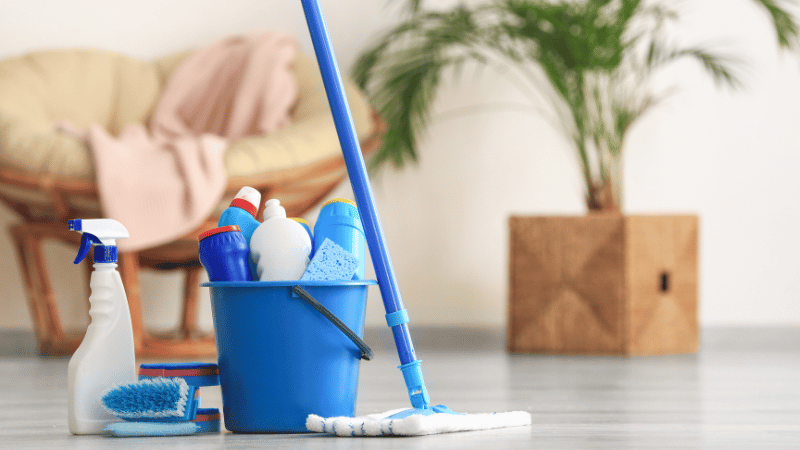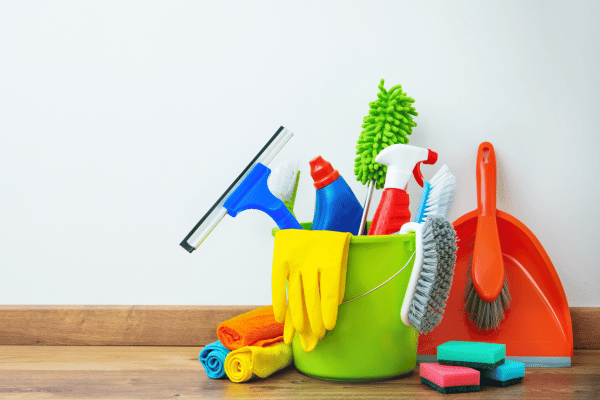Ceiling fans are unsung heroes in keeping your home cool and comfortable, but they often go unnoticed until dust buildup becomes impossible to ignore. A clean ceiling fan does more than just enhance air quality—it helps your fan function efficiently, extending its lifespan and reducing energy consumption.
However, let’s face it: cleaning a ceiling fan can be a tricky, messy task. From balancing on a step stool or ladder to dealing with falling dust, the whole process can feel like a hassle. Still, skipping this chore can lead to dust buildup, which not only gathers on the blades but also circulates into the air you breathe.
With a few practical tools and simple techniques, you can clean ceiling fans without turning your room into a dusty disaster. Keeping them spotless is worth the effort, ensuring a healthier, dust-free environment for you and your family.
How To Clean Ceiling Fan: 3 Simple Steps
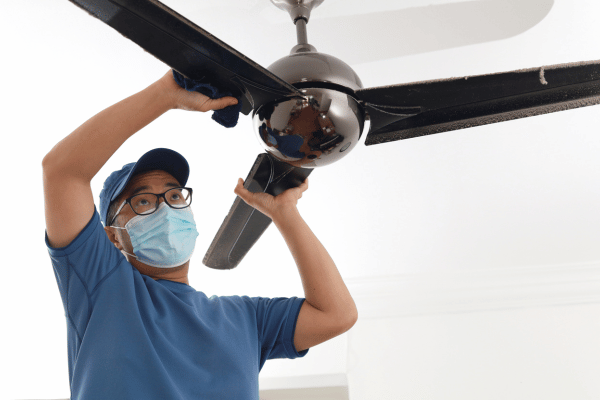
1. Take a Ladder and Detach the Fan from the Ceiling Hook
Cleaning a ceiling fan thoroughly often requires detaching it from the ceiling, especially if dust buildup has accumulated inside the motor housing or on the blades. Before starting, ensure safety by turning off the power to the fan at the circuit breaker. Use a voltage tester to confirm there’s no electricity flowing to the wires.
It’s also important to clean the ceiling fan light fixture, including the glass components, to prevent dust buildup and ensure it remains functional.
Set up a sturdy step ladder or step stool that provides enough height to comfortably reach the ceiling fan. Gather essential tools such as a screwdriver, wire stripper/cutter, adjustable wrench, and pliers. Begin by gently unscrewing the canopy that connects the ceiling fan to the ceiling hook. Carefully support the fan with one hand while detaching it from the hook.
Use the pliers and wire cutter to disconnect the electrical wires, ensuring you mark them for easy reassembly. An adjustable wrench may be needed to loosen bolts or brackets. Always place the fan on a flat surface or drop cloth to prevent scratches and to contain any loose dirt or dust that may fall off during cleaning.
Prioritize safety by wearing gloves to protect your hands and taking extra care not to overreach while on the ladder. If you’re unsure about handling wires, or other tools, consider consulting a professional for this step.
2. Unscrew the Fan Blades from the Fan Head
Once the ceiling fan is safely detached and placed on a flat surface, the next step is to remove the ceiling fan blade from the fan head. This allows for a deeper and more thorough cleaning, ensuring dust buildup, dirt, and grime are completely eliminated. Leaving the blades attached makes cleaning more difficult and risks leaving areas untouched, especially around the screws and edges.
Here’s how to do it:
- Gather Your Tools: You’ll need a screwdriver (usually a Phillips or flathead) and a damp cloth or microfiber cloth to wipe the blades later.
- Locate the Screws: Examine where the blades connect to the fan head. You’ll typically find screws near the base of each blade.
- Unscrew Carefully: Use the screwdriver to loosen and remove the screws holding the blades. Make sure to keep the screws in a safe place for reassembly. As you detach each blade, gently pull it away from the fan head.
This process ensures the fan blades can be cleaned individually without spreading dust onto the motor housing or other components. Removing the blades also helps you inspect for any wear and tear, such as loose dirt or damage to the edges. Once detached, lay the blades flat on a soft surface like paper towel or a drop cloth to dry completely prevent scratching.
By cleaning each blade thoroughly, you can maintain the fan’s performance and keep your room dust-free. Properly cleaned blades also help improve air circulation, making the fan more efficient when reassembled.
3. Cleaning Procedure to Clean Ceiling Fans
In this section, we’ll guide you through the proper steps to clean your ceiling fan, ensuring every part—from the blades to the motor—is spotless and functioning efficiently. You’ll learn how to remove loose dust, use appropriate cleaning tools, and avoid common mistakes that could damage your fan.
Caution: What Not to Do While Cleaning a Ceiling Fan
Before diving in, there are a few safety tips to keep in mind:
- Do not use harsh chemicals: These can damage the finish on the blades and motor housing.
- Avoid soaking components: Excess moisture can cause rust or short circuits. Always use a damp cloth and ensure parts are completely dry before reassembly.
- Don’t neglect the motor: Dust buildup inside the motor can reduce efficiency and cause overheating.
Cleaning the Motor
The motor is the heart of your ceiling fan, and skipping its cleaning can lead to dust accumulation inside, affecting performance. Use compressed air to blow out dust inside and wipe the motor housing gently. Follow up by wiping the exterior with warm water and a dry microfiber cloth. Never spray cleaning solution directly onto the motor or other electrical parts.
Cleaning Specific Fan Types
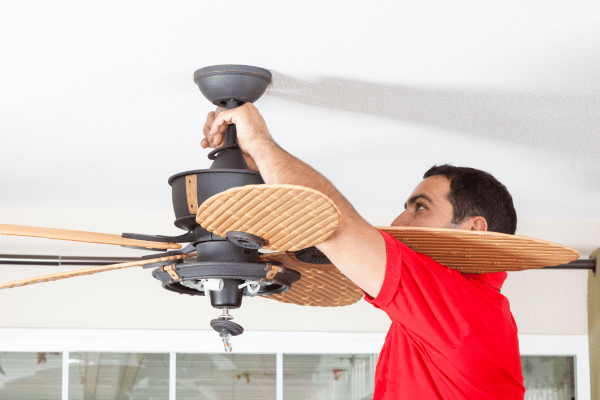
1. Standard Ceiling Fans
Standard ceiling fans are the most common and generally the easiest to clean. Use a dry microfiber cloth or pillowcase method to clean blades and motor housing. Regular maintenance prevents dust buildup and keeps the fan running efficiently.
Always finish by drying the blades completely to avoid streaks or water damage. If your ceiling fan has light fixtures, remember to remove and clean the glass globes. Properly washing and drying the glass globes ensures optimal lighting and fan performance.
2. Fans with Retractable Blades
Fans with retractable blades require extra care as dust can gather in the blade hinges. Gently extend each blade to clean with a damp cloth. Pay attention to hinges where dust can accumulate, and dry blades completely before retracting.
3. High Ceiling Fans
High ceiling fans can be challenging to clean due to their height, but with the right tools, the task becomes manageable. Use an extendable duster or a secure step ladder for safe cleaning.
For deep cleaning, consider professional assistance to avoid safety risks. Clean ceiling fans prevent dust from circulating in the air and maintains the fan’s performance in large spaces.
How to Clean a Ceiling Fan Without a Ladder
Extendable Dusters
Cleaning a ceiling fan without a ladder is not only possible but also simple with the help of an extendable duster. These tools come with a microfiber head that efficiently traps dust without scattering it into the air.
- Reach High Ceilings: Extendable dusters are designed to adjust to various lengths, allowing you to clean fans on high ceilings without the need for a ladder.
- Ease of Use: Simply extend the duster to the required height and swipe it gently across each blade. The microfiber cloth head clings to loose dust and dirt, ensuring thorough cleaning.
- Cost-Effective Solution: These dusters are an affordable and reusable cleaning tool. Their lightweight design makes them convenient for quick and regular maintenance.
For fans with severe dust buildup, lightly spray the duster head with a cleaning solution before use. This method helps remove stubborn grime while keeping the process ladder-free, making it ideal for anyone prioritizing safety and convenience.
Ceiling Fan Cleaning Brushes
A ceiling fan cleaning brush is a light, specialized tool designed for how to clean ceiling fan to make cleaning quick and efficient. Its unique U-shaped design fits snugly around the fan blades, allowing you to clean both sides at once.
- Effortless Cleaning: The U-shaped brush eliminates the need to clean each side of the blade separately, saving time and effort.
- Extendable Handle: Equipped with an extendable handle, these brushes are perfect for reaching high ceiling fans without the need for a ladder.
- Effective Dust Removal: The soft bristles gently remove dust and dirt without damaging the blades, leaving them spotless.
- Versatility: These brushes are not only ideal for ceiling fans but can also be used to clean other hard-to-reach areas like shelves or light fixtures.
Using a ceiling fan cleaning brush is a smart investment for maintaining a dust-free home with minimal hassle.
Pillowcase Method
The pillowcase method is a simple and mess-free way to clean your ceiling fan blades effectively. Here’s how it works:
- Step-by-Step Process:
- Take an old pillowcase and lightly spray the inside with a cleaning solution or dampen it with soapy water for better dust removal.
- Slide the pillowcase over each fan blade, pressing the fabric against both sides.
- Gently pull the pillowcase back while trapping the dust inside, preventing it from falling onto furniture or the floor.
- Safety Tips:
- Wear a mask to avoid inhaling dust particles.
- Use safety glasses to protect your eyes from falling dust.
- Cover your hair with a scarf or cap to keep it clean during the process.
This method is not only efficient but also keeps the cleaning process neat, ensuring your room stays spotless while your fan gets a thorough clean.
Tips to Prevent Fan Dust from Falling Everywhere
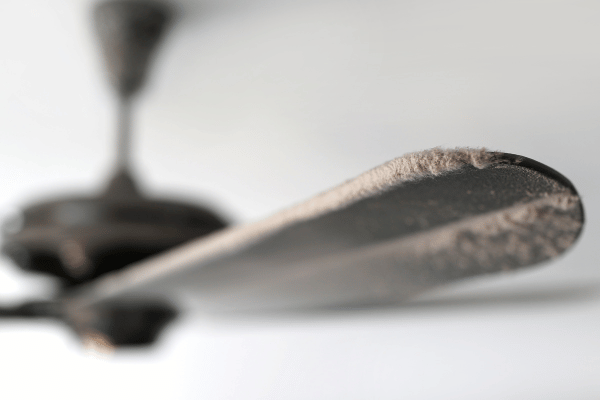
Use a Drop Cloth
Place a drop cloth or old sheets directly beneath the fan before starting the cleaning process. This will catch any falling dust, making cleanup faster and easier.
Try the Pillowcase Method
The pillowcase method is a mess-free solution that traps dust inside the fabric as you clean each blade, preventing it from scattering into the air or onto furniture.
Lightly Spray Dusting Tools
Lightly spray your extendable duster or microfiber cloth with a cleaning solution to reduce loose dust particles from flying around while wiping the blades.
Turn Off HVAC Systems
If your fan is located near an air vent, turn off your HVAC system to prevent airflow from circulating the dust around the room as you clean.
These tips ensure a cleaner, hassle-free experience while keeping your home dust-free.
Let Modern Maids Handle Your House Cleaning Needs
A clean and welcoming home is just a step away with Modern Maids, your trusted provider of professional house cleaning and maid services in Dallas. Our dedicated team ensures every corner of your home is spotless, tidy, and inviting, allowing you to focus on what truly matters.
Ready to experience hassle-free cleaning? Book your professional cleaning service today through our convenient booking page or call us directly at (469)-430-8860. Let us take care of your home while you enjoy peace of mind.
FAQs
1. How do I keep dust from collecting on my ceiling fan?
Regular cleaning is key to preventing dust buildup. Wipe the blades dry with a microfiber cloth every two weeks and lightly spray them with an anti-dust solution to repel dust. Running your fan regularly can also help reduce dust accumulation by keeping the air moving.
2. How often should you clean ceiling fan blades?
Ceiling fan blades should be cleaned at least once a month to prevent dust buildup. For fans in high-traffic areas or homes with pets, consider cleaning them every two weeks for optimal performance.
3. How do you get dust out of a fan without taking it apart?
Use an extendable duster or the pillowcase method to remove dust from blades without disassembling the fan. You can also use compressed air to blow out dust from the motor housing and hard-to-reach areas.
4. What causes a ceiling fan to collect dust so quickly?
Dust collects on ceiling fans due to static electricity generated by the rotating blades. Fans also gather dust from the air, especially in rooms with poor ventilation or high levels of activity. Regular cleaning minimizes this buildup.

